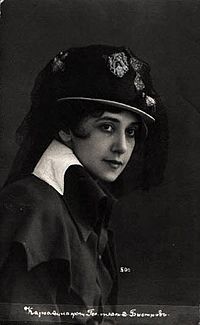Tamara Karsavina facts for kids
Quick facts for kids
Tamara Karsavina
|
|
|---|---|

Tamara Karsavina ((Catalan) 1912)
|
|
| Born |
Tamara Platonovna Karsavina
10 March 1885 |
| Died | 26 May 1978 (aged 93) Beaconsfield, Buckinghamshire, England
|
| Occupation | Ballet dancer |
| Spouse(s) |
|
| Children | 1 |
Tamara Platonovna Karsavina (Russian: Тамара Платоновна Карсавина; 10 March 1885 – 26 May 1978) was a famous Russian ballerina. She was known for her beauty and amazing dancing. Tamara was a main dancer with the Imperial Russian Ballet and later with the Ballets Russes, a famous dance company led by Sergei Diaghilev.
After moving to London, England, she started teaching ballet. She helped create modern British ballet and was a founder of The Royal Ballet. She also helped start the Royal Academy of Dance, which is now the biggest dance-teaching group in the world.
Contents
Early Life and Family
Tamara Karsavina was born in Saint Petersburg, Russia. Her father, Platon Karsavin, was a main dancer and mime (someone who acts without words) with the Imperial Ballet. He also taught at the Imperial Ballet School. One of his students was Mikhail Fokine, who would later dance with Tamara.
Tamara's older brother, Lev Karsavin, became a philosopher and historian. Her family was also distantly related to Aleksey Khomyakov, a poet.
Tamara's father had been a favorite student of Marius Petipa, a famous teacher and choreographer. But their relationship became difficult, and her father had to retire early. Even though he still taught, he was sad about leaving the stage.
Becoming a Dancer
At first, Tamara's father did not want her to study ballet because of his own bad experiences. But her mother really wanted her to dance. Tamara's mother secretly arranged for her to take lessons with a family friend, Vera Joukova, who was a retired dancer.
When her father found out, he accepted the news and even became her main teacher. Tamara said he was her "most demanding teacher." She worked very hard with him.
In 1894, Tamara was accepted into the Imperial Ballet School after a tough test. Her family needed money, so she finished school earlier than usual in 1902. This was unusual because most dancers didn't start professionally until they were 18. Tamara quickly became a leading ballerina with the Imperial Ballet. She danced in all the main ballets by Petipa.
Dancing Career
Tamara Karsavina had many famous roles. Some of her most well-known performances were as Lise in La Fille Mal Gardée, Medora in Le Corsaire, and the Tsar Maiden in The Little Humpbacked Horse. In 1915, she was the first ballerina to dance in the famous Le Corsaire Pas de Deux.
The famous choreographer George Balanchine remembered watching her dance when he was a student. Before 1910, she was often invited to dance in Paris with the Ballets Russes company. With this company, she created many new roles in ballets by Mikhail Fokine. These included Petrushka and Le Spectre de la Rose. She also famously created the main role in Fokine's The Firebird with Vaslav Nijinsky.
Tamara Karsavina left Russia in 1918 and moved to Paris. There, she continued to be a main ballerina with the Ballets Russes. Her brother, Lev Karsavin, was later forced to leave Russia in 1922.
Tamara wrote a book about her life called Theatre Street. It describes her training at the Imperial Ballet School and her career. She was well-liked by almost everyone in the ballet world. She even wrote kindly about her rival, Anna Pavlova.
Personal Life
In 1907, Tamara married Vasili Vasilievich Mukhin. He was a civil servant. He sometimes traveled with her when she was on tour with Diaghilev's company.
After divorcing Mukhin in 1917, Tamara married Henry James Bruce in June 1918. He was a British diplomat. They had one son named Nikita.
Later Years and Legacy
Tamara Karsavina moved to Hampstead, London. She stayed connected with many important people in the ballet world.
She sometimes helped bring back old ballets that she had danced in. For example, she helped dancers like Margot Fonteyn and Rudolf Nureyev with Spectre de la Rose. In 1959, she helped Sir Frederick Ashton with his new version of La Fille Mal Gardée for the Royal Ballet. She taught him the original mime (acting without words) for a famous scene and some of the original dance steps. These parts are still used in the ballet today.
Images for kids
-
Karsavina with Ballets Russes, 1913
-
Tamara Karsavina in Les Sylphides by Savely Sorin
See also
 In Spanish: Tamara Karsávina para niños
In Spanish: Tamara Karsávina para niños
- List of dancers
- List of Russian ballet dancers
- Women in dance









